Articles and News
Yankee Ingenuity: Celebrating American-Made Luxury Watches | July 03, 2013 (0 comments)
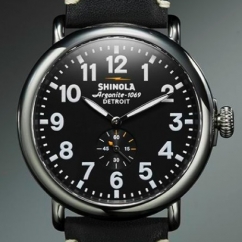
Merrick, NY—At one time, American watch companies were important players in the international watch market. While never as dominant as the Swiss in terms of the number of watch brands we could claim as native, from the 19th century through the mid-20th century, the American watch industry had plenty of reason to be proud of the quality of timepieces we did produce. Iconic American brands such as Hamilton, Bulova, Tiffany, and even Timex were—and still are—renowned for their technology, design, and quality, but most now are largely if not fully made abroad. Other famed American brands like Elgin (Illinois) and Waltham (Massachusetts) either no longer exist or are no longer sold here.
But a few luxury watches--even $100,000 super-luxury watches--are American made, or at least hand-built here by skilled watchmakers—providing American jobs—even if some of their tiny components are by necessity sourced in Europe. But with a rising interest among consumers to buy American made luxury goods, The Centurion Newsletter looks at American luxury watch brands, just in time for our nation’s 237th birthday.
RGM Watch Company, Mount Joy, Pennsylvania
Founded in 1992 by Baltimore-born Roland G. Murphy, RGM Watch Company is renowned for its bespoke timepieces, such as the Caliber 801 and the Pennsylvania Tourbillon, honoring its home in Mount Joy, a small town near Lancaster, PA, an area rich in watchmaking tradition.
RGM seeks to keep the great traditions of fine watchmaking in focus. Modern manufacturing co-exists with antique, hand-operated machinery. Hand-blued screws and hand-polished components are at home among the close tolerances afforded by automated machines. The company’s website states its goal is to offer not only the finest watches made in the USA, but the finest watches available, and to that end, believes this requires equal efforts to improve current methods while at the same time preserving tradition.
RGM is located in a historic bank building in Mount Joy, and is proud of manufacturing watch parts, cases and movements in the USA. To commemorate its 20th anniversary last year, the company announced the Caliber “20", its third in-house American-made movement. Prices range from $2,200 for a basic Pilot 107P to more than $95,000 (for the Pennsylvania Tourbillon in stainless; contact RGM for pricing in gold or platinum).
Read more about RGM here and here and watch a video interview with Roland G. Murphy here.
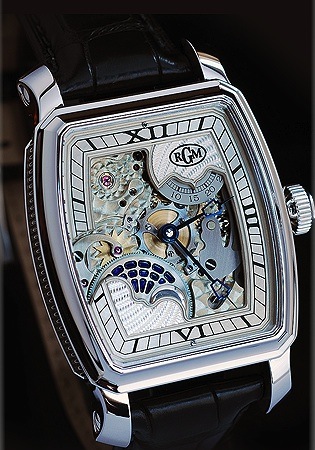
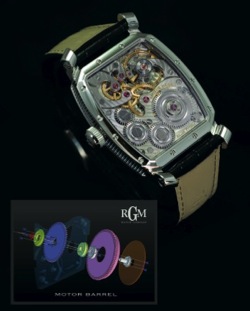
RGM's "Motor Barrel Caliber 20" recalls the grand era of American railroad watches. The motor barrel was an American invention, with the benefit of the design being reduced friction and in the mainspring barrel bearing surfaces, transferring power more effectively. Case is American-made polished stainless steel with sapphire crystal front and display back, 42.5 mm by 38.5 mm, with hour, minute, seconds, and moon phase functions. Caliber is RGM 20, American made, 19 jewel, manual wind, dial is solid silver, skeleton, or full guilloche, hands are blued steel keystone hour and minute, strap is brown or black Louisiana alligator with signed RGM stainless steel buckle. At right, a reverse view with an inset showing the motor barrel mechanism.
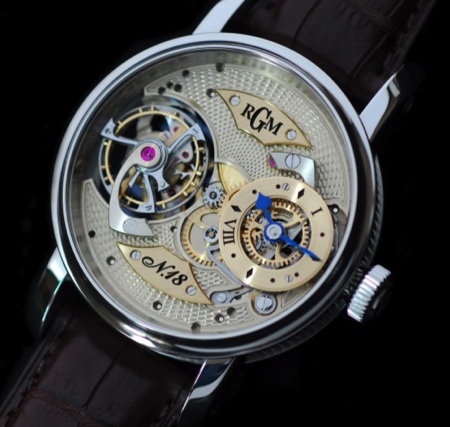

Left: The Pennsylvania Tourbillon, RGM’s flagship mechanical watch, is the first tourbillon made in a series in the United States. The handcrafted watch is built one at a time by RGM’s watchmakers, using traditional watchmaking tools and techniques. Only a few are produced each year. The case is American made polished stainless steel with sapphire crystal and sapphire display back and side window. Size is 43.5 mm by 13.5 mm. Movement is one minute tourbillon, 19 jewels, American made. Dial is solid Argentium silver, hour and minute hands are blued steel, strap is brown or black Louisiana alligator with signed RGM brushed-finish stainless steel buckle.
Right: A rear view of the company's Caliber 801 watch.
Towson Watch Company, Baltimore, Maryland
The Towson Watch Company LLP was founded in 2000 by George Thomas and Hartwig Balke. According to the company’s website, the two met in a pub in Annapolis, MD, a popular place for boaters in the Chesapeake Bay region to dock. Thomas is a master watchmaker with 40 years’ experience repairing high-grade watches, repeaters, and chronographs, and making his own tourbillion watches. Balke is a graduate in mechanical engineering and talented watchmaker. They discovered their common love for high-grade mechanical watches, and before returning to their respective boats, promised to meet again to pursue their dream of building fine timepieces.
Thomas had built his first tourbillion pocket watches—displayed now at the National Watch and Clock Museum in Columbia, PA—in 1985, when he was already 53 years old. 14 years later, in 1999, Balke—then 56—made his first wrist chronograph. He’d made it for a NASA astronaut, who wore it during the first space mission in the new millennium, the STS-99 Mission. A second watch, worn during the same mission, also is on display at the museum.
The pair’s first 25 chronographs sold out within weeks. The watches are made in limited series, using both modern and old traditional watchmaker tools and machines—some of which are more than 100 years old. Experienced watchmakers and craftsmen take care of not only TWC timepieces, but also are skilled in restoration, engraving, and repair of other antique timepieces like old traditional English lever, fusee watches, or Swiss high grade multi complications, repeaters, and chronographs.
Thomas and Balke named their collection the Chesapeake Class Watch Collection, after the region where they met and founded their dream business. Individual timepieces bear names such as Bay Pilot, in honor of the Chesapeake Bay, or Potomac or Choptank, rivers that flow into the Chesapeake. Watches range from mid-priced (the $2,450 Bay Pilot) to more than $10,000. The company also makes rare specialty items such as a bespoke classic pocket watch ($14,750) or a gold or silver spherical watch.

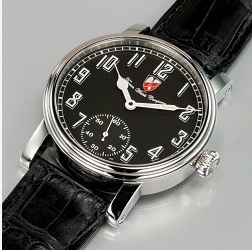
Above left: The Benzinger Classic has a solid silver engine turned dial with black Roman numerals and blued steel Breguet-style hands. A hig- grade 17-jewel manual winding movement was taken apart and all the bridges and balance cock were skeletonized , engraved and rose gold plated. The plate was engine turned and rhodium plated. In its final assembled stage, the watch is a one-of-a-kind collectible and is priced at $10,150.
Above right: BayPilot BP 250-L model ($2,450) comes with a genuine crocodile leather band. It has a 42 mm diameter stainless steel case, black dial with white luminous numerals, white luminous hands, sapphire crystal at front and back, 17 jewel manually wound movement adjusted with swan neck fine regulating device, Nivarox hairspring, Glucydur balance with screws, Incablock shock absorption, and is water resistant to 5 atm, (50m).
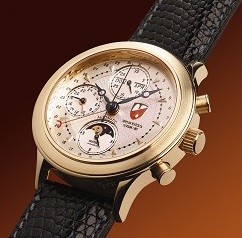
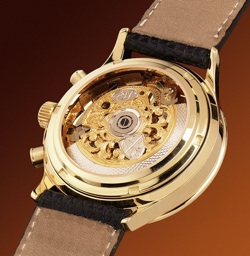
Towson Watch Co. Gold Moon Phase Chronograph “Masterpiece” case (front view, left; rear, right) is 18k gold with scratch resistant sapphire crystal at front and back, crown and pusher in solid 18k gold, water resistant to 3 atm (30m). Hand-engraved moon phase chronograph movement has special 3/4 size winding bridge; base caliber 7751. Bicolor, hand engraved rotor with engine turned (guilloche) mass. Rotor displays the crest of the Towson Watch Company. Silver dial, blued steel Breguet-style hands. Watch offers sweep second start, stop, re-start or reset and 30 minute and 12 hour register, plus two small windows in the 30 min. register display day and month. An additional hand indicates the date on the dial’s outer circle and a special shaped section in the 6-hour register shows the moon phase. At the 9 o'clock position is a 24-hour register. Priced at $13,500.
Geoffrey Roth/Sedona Watch Works, Sedona, Arizona
When Geoffrey Roth moved to Sedona from Buffalo, NY, he knew he was going to open a gallery. He just didn’t know was what it was going to sell. But Roth, an artist by nature, soon taught himself to make beautiful handcrafted hardwood boxes. Next came pewter and Brazilian rosewood belt buckles, and from there it was only a short step to fine jewelry. As his website explains, both his successful gallery and jewelry line grew over the years, but still something was missing: a watch.
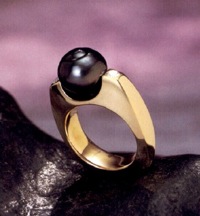
An 18k gold and Tahitian pearl ring by Geoffrey Roth. He no longer makes jewelry and he retired his retail gallery in 2011, but he's still building watches.
Perhaps it was the ghost of Roth’s Swiss ancestors, but he’d always been fascinated by watches and longed to create his own luxury wristwatch. Working directly with Swiss companies for all the components proved to be a nightmare, so today Roth machines and engraves the cases (in stainless or Damascus steel or 18k rose gold), crowns, dials, and hands in his studio, but the movements are Swiss ETA.
“People call me an artist, but my primary concern is with precision, machines, and what I can do with my hands. If I hadn’t wanted to be an artist, I would have been an engineer,” Roth once told Sedona magazine. “I had been intrigued with the idea of creating an exceptionally accurate and particularly beautiful timepiece, giving the watch signature status,” he said.
After 38 years, Roth closed his retail gallery in late 2011 to focus exclusively on his watches, both servicing existing models and creating new ones such as the Tonneau model he launched in 2012. Each new model takes about two to three years from concept to finalization, and each individual watch is hand-built and takes four to eight weeks to complete. Roth makes about 20 per year. Prices range from $5,500 to $21,500.
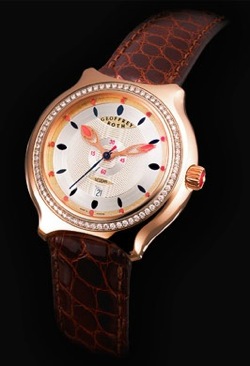
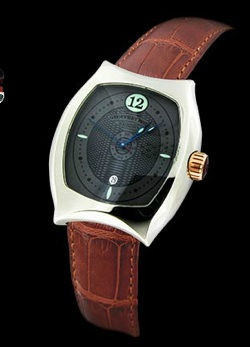
Left: Midsize watch designed and built by Geoffrey Roth has 18k rose gold case with an 18k rose gold diamond bezel. Brown shiny Louisiana far- raised alligator strap has double deployment buckle. Water resistant up to 5 atm. Right: The tonneau features a stainless steel case, industrial high tech hard coated dial, 18k rose gold crown with synthetic ruby and genuine blue sapphire, cognac Louisiana far- raised alligator strap.
Shinola Watches, Detroit, Michigan
If there’s one city that can attest to the pain of losing American manufacturing dominance, it’s Detroit. Once the beacon of Yankee auto muscle—indeed, where the assembly line originated—Detroit has suffered perhaps more than most rust-belt cities. Where Pittsburgh, PA, long ago knocked its empty steel factories down and began to focus on education and healthcare as its new industries of record, Detroit is just now beginning a hopeful renaissance.
At the vanguard is a company called Shinola, with a diverse line of products—bicycles, journals, leather goods, and watches—that have one thing in common: they’re made in the USA. Whether made in the Detroit factory as the watches are, or in conjunction with other American partners like the leather, journals, and bicycles are, “bringing back manufacturing to America is an integral part of our company,” says spokesperson Trish O’Callaghan.
Shinola watches are the company’s newest venture. In partnership with Swiss firm Ronda AG, Shinola transformed 30,000 square feet of raw space into a state-of-the-art watch factory inside the College for Creative Studies within the historic Argonaut building in Detroit. The company leads student design workshops, and its production combines meticulous hand-assembly with advanced technology to ensure the watches are both beautiful and built to last. Like its other products, Shinola watches’ design embody a quintessentially American sensibility—clean, unfussy, classic, and functional.
Some of Shinola’s assemblers had experience building cars (this is, after all, Detroit) but none had ever built a watch. Ronda’s team literally at times put their arms around Shinola employees’ necks to teach, by feel, the way the tiny movement pieces should go.
“They got to know each other really well!” laughs O’Callaghan. View this short film to watch the training process of the Shinola watch assembly team.
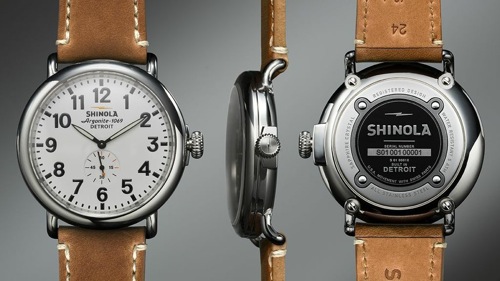
Shinola Runwell style S 01 00010 has a brown strap, white dial, and 47mm case. Retail, $550. Runwell style S 01 00020, shown at the top of the page, has a black strap and black dial with a 40mm case. Retail, $550. Photos: Greg Vore
The watches themselves embody a classic American sensibility in their design. The movements are Swiss but the timepieces are entirely assembled in Detroit, and the leather for the straps comes from Chicago-based Horween leather, another Shinola partner. The leather is made into watch straps by Florida-based Hadley-Roma.
Distributed by ViewPoint Showroom, O’Callaghan says Shinola watches are exclusive to Barneys New York through August, after which they will be available in select specialty retailers like Saks and Neiman Marcus, and in some leading luxury jewelers such as Tivol, Tiny Jewel Box, Reis Nichols, Lux, Bond & Green, Reinhold, IW Marks, and Orr’s.
Priced between $475 and $725, it’s positioned as an affordable luxury—with, of course, the added benefit of providing jobs for Americans.
Read more about Shinola’s factory, assemblers, and watchmakers here.
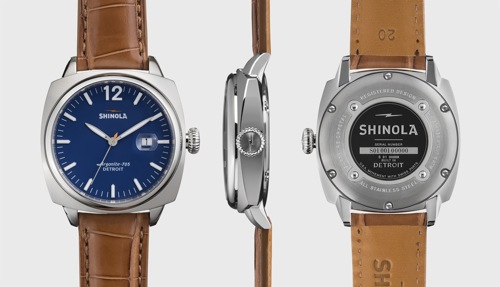
Shinola Brakeman style S 01 00006 has a tan alligator strap with deployant buckle, blue dial, and 42mm case. Retail, $675. Photo: Shinola
Cadence Watch Company, Philadelphia, Pennsylvania
Cadence watches began in Cambridge, MA in 2002, when Harvard student Vanya Buvac patented a watch for crew rowers to measure stroke rate; hence, the name “Cadence.”
The company moved to Philadelphia in 2004, employs local designers, and even runs an ongoing, open design competition for the public. Though the watches are actually made in China, Hong Kong, and Japan, they are mostly designed in Philadelphia, either by Buvac or by the local designers he hires, plus competition winners, and even students from one of Philadelphia’s many art schools.
With styles geared to Millennials, Cadence watches are priced between $80 and $495, but its business model calls for huge discounts to email subscribers and social media followers, so its actual selling range is closer to $20 to $150, says marketing director Christopher Munden. The highest-price (listed) is $1,080 for its Executive model.
The company has had the odd retail account—and in the long run probably will need to move into retail to continue growth—says Munden, but for now it’s concentrating on e-commerce.
Do Millennials even wear watches?
“Because cellphones are ubiquitous, watches aren't seen as a necessity [to Millennials], but as an accessory and a social marker. But we've found that watches we've targeted to young customers appeal to older customers more. Our Wrist Rocket line is popular, because the numbers are so large and easy to read,” laughs Munden.
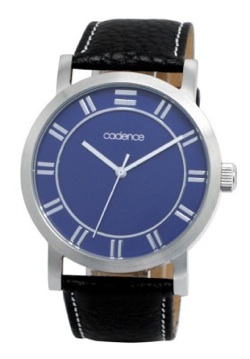
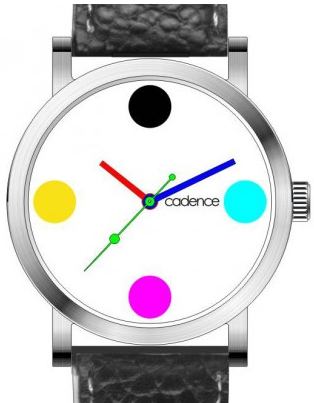
Left, Cadence's new $175 “EQL Equality” watch, celebrating LBGT Pride Month and the recent victory for gay marital rights. Right, its CMYK watch appeals to graphic and web designers, using the print CMYK (cyan, magenta, yellow, black) four-color scale for the 12, 3, 6, and 9 o'clock hour markers and the digital RGB (red, green, blue) color scale for the hands.







